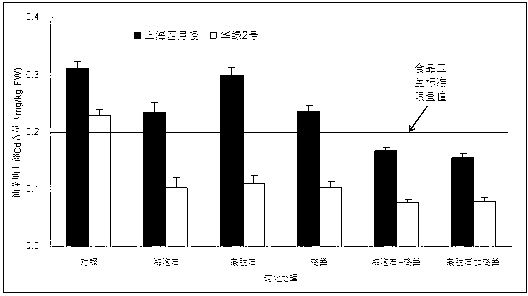Method for reducing cadmium pollution risk for rape
A cadmium pollution, rapeseed technology, applied in the restoration of polluted soil, chemical instruments and methods, botanical equipment and methods, etc., can solve the research on screening rapeseed Cd rejection varieties. There are few reports and no passivation agents are given. , without giving the risk of cadmium pollution, soil passivators and other issues, to reduce the risk of threatening human health, reduce mobility and bioavailability, and reduce the risk of cadmium pollution in vegetables.
- Summary
- Abstract
- Description
- Claims
- Application Information
AI Technical Summary
Problems solved by technology
Method used
Image
Examples
Embodiment
[0022] Example: Field experiments to reduce the risk of cadmium pollution in rapeseed
[0023] The experimental site is located in the sewage irrigation vegetable field of Dabizhuang Town, Dongli District, Tianjin. The vegetable field is located in the Beipaihe sewage irrigation area of Tianjin. Since the 1970s, urban domestic sewage and industrial sewage have been used for irrigation for a long time. The soil and production vegetables are polluted by heavy metals. The basic physical and chemical properties of the soil in the demonstration sites are as follows: pH value 7.8, cation exchange capacity CEC 17.5 cmol / kg, organic matter content 4.56%, average total cadmium content 2.8 mg / kg, and average total lead content 117.2 mg / kg. According to the national soil environmental quality standard, the vegetable field soil is moderately polluted by cadmium.
[0024] There are 6 passivation treatments in the experiment, including: (1) control treatment, no passivation material is a...
PUM
 Login to View More
Login to View More Abstract
Description
Claims
Application Information
 Login to View More
Login to View More - R&D
- Intellectual Property
- Life Sciences
- Materials
- Tech Scout
- Unparalleled Data Quality
- Higher Quality Content
- 60% Fewer Hallucinations
Browse by: Latest US Patents, China's latest patents, Technical Efficacy Thesaurus, Application Domain, Technology Topic, Popular Technical Reports.
© 2025 PatSnap. All rights reserved.Legal|Privacy policy|Modern Slavery Act Transparency Statement|Sitemap|About US| Contact US: help@patsnap.com


